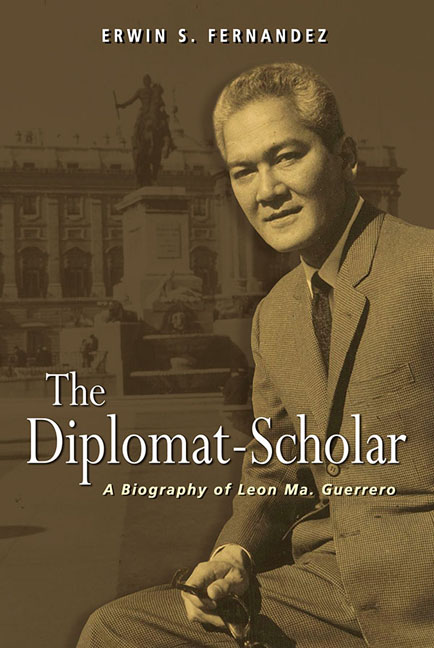Book contents
- Frontmatter
- Dedication
- Contents
- Preface
- Prologue
- Chronology
- I Ermita and Santa Cruz to Intramuros: Between Literary and Legal Career
- II To Tokyo and Back: The Making of a Diplomat
- 5 The Assistant Solicitor
- 6 From Intelligence Officer in Bataan to the Return of Ignacio Javier
- 7 Second, then First Secretary
- 8 At the Home Office: The Diplomat as Historian
- III Going In, then Out of the Political Jungle: Padre Burgos to Arlegui
- IV London and Madrid: The Philippines in a Resurgent Asia
- V New Delhi to Belgrade: The Philippines towards Non-Alignment
- Epilogue
- Glossary
- List of Abbreviations
- Bibliography
- Index
- About the Author
5 - The Assistant Solicitor
from II - To Tokyo and Back: The Making of a Diplomat
Published online by Cambridge University Press: 12 January 2018
- Frontmatter
- Dedication
- Contents
- Preface
- Prologue
- Chronology
- I Ermita and Santa Cruz to Intramuros: Between Literary and Legal Career
- II To Tokyo and Back: The Making of a Diplomat
- 5 The Assistant Solicitor
- 6 From Intelligence Officer in Bataan to the Return of Ignacio Javier
- 7 Second, then First Secretary
- 8 At the Home Office: The Diplomat as Historian
- III Going In, then Out of the Political Jungle: Padre Burgos to Arlegui
- IV London and Madrid: The Philippines in a Resurgent Asia
- V New Delhi to Belgrade: The Philippines towards Non-Alignment
- Epilogue
- Glossary
- List of Abbreviations
- Bibliography
- Index
- About the Author
Summary
At Arzobispo Street in Intramuros, Leon Ma. Guerrero started to work as assistant solicitor in the Office of the Solicitor General in the last quarter of 1940. Solicitor General Roman Ozaeta entrusted to him the preparation of the brief on the appeal case of Ferdinand E. Marcos, a brilliant Ilocano law student accused of murdering Julio Nalundasan, the electoral opponent of his father.
In December 1938 Guerrero, then a senior law student, had read from the headlines that a fellow law student by the name of Marcos was arrested. Vicente J. Francisco, a leading trial lawyer, handled the case that implicated not only Marcos but also his father Mariano, his uncle Pio, both lawyers, and Quirino Lizardo as accomplices. Delaying tactics were employed by the defendants so that Marcos could take the bar exam in August. Marcos took the bar that Guerrero took in four successive Saturdays. In the first week of September, the four accused went on trial and finally in late November, Judge Roman Cruz of Laoag declared Marcos and Lizardo guilty of murder but absolved the father and the uncle. Marcos, however, topped the bar; he applied for provisional liberty on bail to appeal his case before the Supreme Court but the motion was denied until President Quezon informed Cruz that he was amenable to it. Marcos insisted on winning his appeal before the magistrates of the highest court. In less than a year, he prepared his brief proving his innocence of the crime. Thus, Marcos the appellant and Guerrero the prosecutor met for the oral arguments on the appeal as scheduled by the Supreme Court on 12 October 1940.
A precedent in Philippine legal history, it was the first time that a twenty-three-year-old convicted murderer would argue his case before the high bench. That Saturday, at the Ayuntamiento, members of the Manila bar, conspicuous in their black togas, packed the court hall. Outside, a throng of spectators, mostly law students, cheered for Marcos who wore a white suit and white shoes. Members of the diplomatic corps and a representative from the Office of the American High Commissioner were present.
- Type
- Chapter
- Information
- The Diplomat-ScholarA Biography of Leon Ma. Guerrero, pp. 67 - 72Publisher: ISEAS–Yusof Ishak InstitutePrint publication year: 2017

